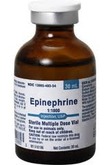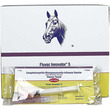Pronunciation
ep-eh-NEF-rin - Pronunciation guide
Brand Names
- Epinephrine
- Epinephrine 1:1000
- Epinephrine Injection USP
- EpinJect
Description
 Epinephrine is a hormone secreted by the adrenal medulla and released into the bloodstream in response to physical or mental stress. It initiates bodily responses, including stimulation of the heart rate, increase in blood pressure, increase in metabolic rate, and increase in blood glucose concentration. Medicinally, it is a crystalline compound isolated from adrenal glands and synthesized for use as a heart stimulant, vasoconstrictor, bronchial relaxant, and is also used in cases of glaucoma.
Epinephrine is a hormone secreted by the adrenal medulla and released into the bloodstream in response to physical or mental stress. It initiates bodily responses, including stimulation of the heart rate, increase in blood pressure, increase in metabolic rate, and increase in blood glucose concentration. Medicinally, it is a crystalline compound isolated from adrenal glands and synthesized for use as a heart stimulant, vasoconstrictor, bronchial relaxant, and is also used in cases of glaucoma.
Usage
Epinephrine is used in emergencies to treat very serious allergic reactions, or anaphylactic shock reactions to insect stings/bites, foods, drugs, or other substances. When an animal is known to have anaphylactic reactions, a veterinarian will often prescribe a supply of epinephrine to be kept on hand for use in emergencies.
Epinephrine is used in foal resuscitation and cardiopulmonary resuscitation of newborn foals.
Epinephrine is also added to local anesthetics to retard systemic absorption and prolong effect.
As an ophthalmic/adrenergic agonist, it is used for meiosis refractory and atropine treatment, and in the treatment of glaucoma.
Dosage and Administration
 Epinephrine Epinephrine |
||||
|---|---|---|---|---|
| Method | Dosage (click row for calculator) |
Concentration | Period | Duration |
| Intramuscular or Subcutaneous injection | 1-2 ml 1 | 1:1000 solution | Treatment | NA |
| Intramuscular or Subcutaneous injection | 1 ml/100lb 2 | 1:1000 solution | Treatment | NA |
| Intravenous injection | 0.1 ml/kg 3 | 1:1000 solution | Treatment | NA |
Notes:
|
||||
Side Effects
Rapid heart rate, nervousness, sweating, shakiness, and respiratory rate increase are common side effects.
Precautions
Epinephrine should be prescribed and administered by a veterinarian. Keep horse out of sunlight--preferably in a dark area.
Interactions
Caution should be used when a horse is on beta blockers, dioxin, chlorpromazine, or diuretics, such as furosemide.
Overdose
Overdose will result in heightened side effects mentioned above.
Images
 Epinephrine
Epinephrine
 Epinephrine Injection
Epinephrine Injection
Literature
